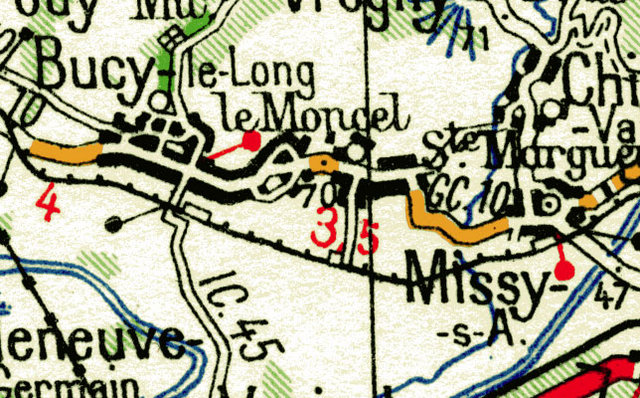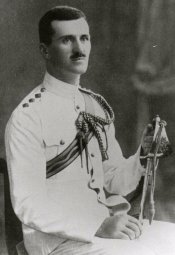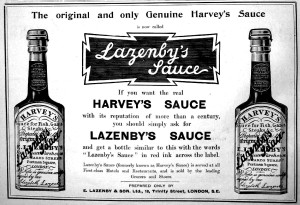15th September 1914
The Dorsets returned to their sunken road at 4am. I’ve had a think about the location of this road overnight. I’m guessing they were using it as a pre-dug trench. It must have run north to south to protect the troops from shellfire coming in from the east. Gleichen mentions that the Dorsets were “pushed on to help the 12th, and filled a gap in their line on the hill above the village front at the eastern end.” So I think it was either the little lane called Petit Chivres or Rue du Moulin de Laffaux, probably the former as it’s pushed further ahead than the actual village. It appears on Google maps to be heavily hedged and run beneath the surface of the surrounding fields. All the other nearby roads run along the surface of the land.
Rolt’s farm is mentioned by Gleichen over the next few days so I’ve located that on the map from his small drawing in his book. I’ve also located the farm at La Biza again as it remained the 15th Brigade’s HQ. I’m going to assume that the Dorsets’ diary refers to this location when it mentions La Bezaie farm.
An hour later, at 5am, the Dorsets received a message that the Chivres spur was about to be attacked again in a joint operation between the 15th and 13th Brigades. The Dorsets remained under the care of the 14th Brigade as reserve battalion.
By 1pm the news came back that the attack had broken down. General Stuart Peter Rolt, Commander of the 14th Brigade, ordered the Dorsets to join the best of the 215th Brigade in Missy. At 2pm they moved to “Rolt’s Farm” and then spread out. Frank’s A Company was ordered to occupy a small green hill 600 feet east of the farm, while C Company was to remain in support. The hill is visible on Google Maps if you turn on view terrain. A Company immediately caught the attention of a German machine gun. Several men were hit.
The remaining Companies were ordered to move south down the little stream that ran past a mill. They dug themselves into the bank.
At about 3pm the Dorsets were surprised by Gleichen and Brigade Major Weatherby leaping through the hedges coming the other way followed by an angry swarm of German bullets.
We must have offered very sporting targets to the Germans on the hill, for we ran all the way, and—I speak for myself—we got extremely hot.
The Dorsets received orders at 5pm to move towards Missy and entrench the line south of La Biza down to the railway. I’ve had a look for this railway to see if there are any marks left in the ground, but it’s long gone, although the land is scored with what could be old trenches. I’m assuming the railway line ran where the D925 road now passes the bottom of the village.

It’s not clear how far the Dorsets got in digging their new line. At 9pm the order came for them to retire south of the Aisne. They crossed a new pontoon bridge which had appeared next to where Johnston’s rafts were the day before. The enemy’s search lights played over the water as they crossed but they were not seen and retired to the billets in the relative safety of Jury.
The Dorsets’ war diary records 1 killed with 21 wounded and 4 missing. The CWGC reports 8 dead from this area of operations. Some of Frank’s close friends must have been included in this grim harvest.
Missy was “a locality of great interest” according to Sir John French.
“On the 15th my impression of the previous day, namely, that the enemy was making a firm stand in his actual position, was confirmed also by an intercepted German wireless message. It seemed probable that we had the whole of the German 1st Army in front of us.”
The 5th Division was still waiting for heavy artillery to come up and support the exposed troops on the northern banks. The Germans were one step ahead. The increase of “Black Marias” and other monstrous shells indicated that the large siege guns had finished smashing Belgian forts and were now ominously sited on the heights about the Aisne. Faced with an entire army and their massed artillery, there was only one option left to the men of the BEF. To dig. Dig in and entrench or face annihilation.


